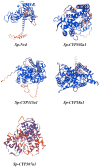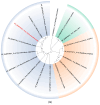Identification and Evolution Analysis of the Genes Involved in the 20-Hydroxyecdysone Metabolism in the Mud Crab, Scylla paramamosain: A Preliminary Study
- PMID: 39766853
- PMCID: PMC11675983
- DOI: 10.3390/genes15121586
Identification and Evolution Analysis of the Genes Involved in the 20-Hydroxyecdysone Metabolism in the Mud Crab, Scylla paramamosain: A Preliminary Study
Abstract
Background: 20-Hydroxyecdysone (20E) is the most ubiquitous ecdysteroid (Ecd) and plays critical roles during the life cycle of arthropods. To elucidate the metabolism pathway of 20E in the economically important species, Scylla paramamosain, we conducted a comprehensive exploration of the genes involved in the 20E metabolism pathway.
Methods: A comprehensive exploration of genes involved in the 20E metabolism pathway was conducted, including gene annotation, local blast using the Drosophila ortholog as query, and TreeFam ortholog genes identification. Bioinformatics and expression profiling of the identified genes were performed to assess their roles in the 20E metabolism of green mud crabs.
Results: This experiment indicated that, except for CYP306a1 and CYP314a1, all other ortholog genes involved in the Drosophila 20E metabolism can be found in the mud crab, suggesting that the function of these two genes might be replaced by other CYP genes or the "active" Ecd in mud crabs was not the 20E. All genes had the typical features of each gene family, clustered with the specific clade in the phylogenetic trees. In addition, all the identified genes had the highest expression level in the Y-organ, and sex-biased gene expression was observed in these genes.
Conclusions: This study provided some valuable insights into the metabolism and diversity of ecdysteroids in crustaceans.
Keywords: CYP18a1; CYP302a1; CYP307a1; Neverland; Scylla paramamosain; Y-organ.
Conflict of interest statement
The authors declare no conflicts of interest.
Figures









Similar articles
-
Ecdysone receptor in the mud crab Scylla paramamosain: a possible role in promoting ovarian development.J Endocrinol. 2015 Mar;224(3):273-87. doi: 10.1530/JOE-14-0526. Epub 2015 Jan 6. J Endocrinol. 2015. PMID: 25563354
-
Effects of molting on the expression of ecdysteroid biosynthesis genes in the Y-organ of the blackback land crab, Gecarcinus lateralis.Gen Comp Endocrinol. 2023 Sep 1;340:114304. doi: 10.1016/j.ygcen.2023.114304. Epub 2023 Apr 29. Gen Comp Endocrinol. 2023. PMID: 37127083
-
Macrophage migration inhibitory factor (MIF) family in arthropods: Cloning and expression analysis of two MIF and one D-dopachrome tautomerase (DDT) homologues in mud crabs, Scylla paramamosain.Fish Shellfish Immunol. 2016 Mar;50:142-9. doi: 10.1016/j.fsi.2016.01.030. Epub 2016 Jan 27. Fish Shellfish Immunol. 2016. PMID: 26826424
-
Identification and Evolution Analysis of the Complete Methyl Farnesoate Biosynthesis and Related Pathway Genes in the Mud Crab, Scylla paramamosain.Int J Mol Sci. 2022 Aug 21;23(16):9451. doi: 10.3390/ijms23169451. Int J Mol Sci. 2022. PMID: 36012717 Free PMC article.
-
Identification and characterization of six peroxiredoxin transcripts from mud crab Scylla paramamosain: The first evidence of peroxiredoxin gene family in crustacean and their expression profiles under biotic and abiotic stresses.Mol Immunol. 2018 Jan;93:223-235. doi: 10.1016/j.molimm.2017.11.029. Epub 2017 Dec 6. Mol Immunol. 2018. PMID: 29220745
Cited by
-
Genome-Wide Association Study for Weight-Related Traits in Scylla paramamosain Using Whole-Genome Resequencing.Animals (Basel). 2025 Jun 20;15(13):1829. doi: 10.3390/ani15131829. Animals (Basel). 2025. PMID: 40646730 Free PMC article.
References
-
- Savchenko R.G., Veskina N.A., Odinokov V.N., Benkovskaya G.V., Parfenova L.V. Ecdysteroids: Isolation, chemical transformations, and biological activity. Phytochem. Rev. 2022;21:1445–1486. doi: 10.1007/s11101-021-09792-y. - DOI
-
- Huang S., Chen J., Chen X., Chen Y., Yue W., Wang J., Wang C. Dynamic analysis of ecdysteroid hormone content and molting related genes expression in the molting cycle of Chinese mitten crab (Eriocheir sinensis) J. Agric. Biotechnol. 2018;26:150–158.
-
- Okumura T., Kamba M., Sonobe H., Aida K. In vitro secretion of ecdysteroid by Y-organ during molt cycle and evidence for secretion of 3-dehydroecdysone in the giant freshwater prawn, Macrobrachium rosenbergii (Crustacea: Decapoda: Caridea) Invertebr. Reprod. Dev. 2003;44:1–8. doi: 10.1080/07924259.2003.9652548. - DOI
MeSH terms
Substances
LinkOut - more resources
Full Text Sources
Research Materials

